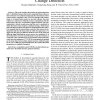131
click to vote
ADHOC
2006
15 years 21 days ago
2006
This work introduces the concept of a Wireless Underground Sensor Network (WUSN). WUSNs can be used to monitor a variety of conditions, such as soil properties for agricultural ap...
119
Voted
CORR
2008
Springer
15 years 22 days ago
2008
Springer
A set of N independent Gaussian linear time invariant systems is observed by M sensors whose task is to provide the best possible steady-state causal minimum mean square estimate o...
CORR
2008
Springer
15 years 22 days ago
2008
Springer
This paper presents an analysis of target localization accuracy, attainable by the use of multiple-input multiple-output (MIMO) radar systems, configured with multiple transmit and...
102
Voted
CORR
2008
Springer
15 years 22 days ago
2008
Springer
This work considers the problem of quickest detection with N distributed sensors that receive sequential observations either in discrete or in continuous time from the environment....
101
Voted
CORR
2008
Springer
15 years 22 days ago
2008
Springer
Abstract--The paper introduces DILOC, a distributed, iterative algorithm to locate sensors (with unknown locations) in 1, with respect to a minimal number of + 1 anchors with known...
CORR
2010
Springer
15 years 22 days ago
2010
Springer
This paper investigates the decentralized detection of Hidden Markov Processes using the NeymanPearson test. We consider a network formed by a large number of distributed sensors....
101
click to vote
AUTOMATICA
2010
15 years 23 days ago
2010
Collaborative signal processing and sensor deployment have been among the most important research tasks in target tracking using networked sensors. In this paper, the mathematical...
133
click to vote
AROBOTS
2008
15 years 23 days ago
2008
Autonomous mobile robots need to adapt their behavior to the terrain over which they drive, and to predict the traversability of the terrain so that they can effectively plan thei...
117
Voted
ICASSP
2010
IEEE
15 years 25 days ago
2010
IEEE
The energy-distortion function (E(D)) for a network is defined as the minimum total energy required to achieve a target distortion D at the receiver without putting any restricti...
97
Voted
AIPS
2009
15 years 1 months ago
2009
Nowadays many urban areas have been equipped with networks of surveillance cameras, which can be used for automatic localization and tracking of people. However, given the large r...



